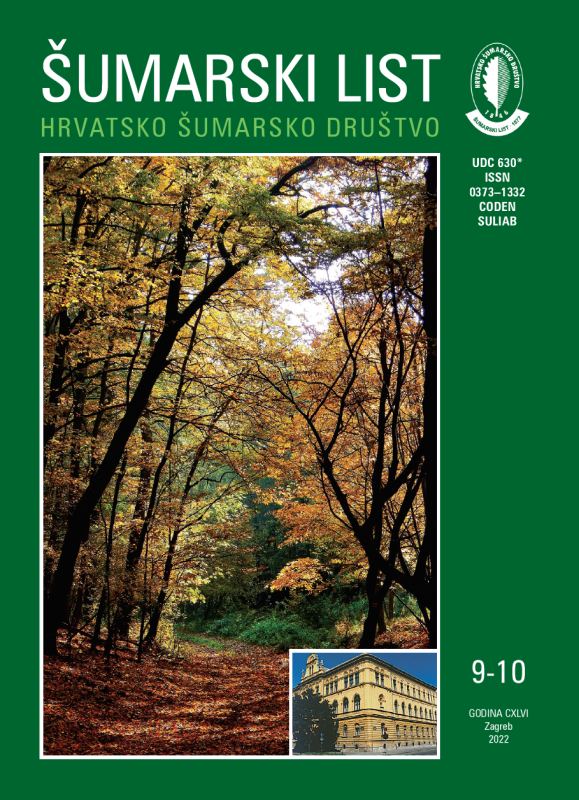
broj: 9-10/2022
pdf (15,8 MB) |
|
||||||||||||||
| RIJEČ UREDNIŠTVA | ||
| Uredništvo | ||
| Forests in the service of decentralisation and demographic recovery of Croatia pdf HR EN | 385 | |
| IZVORNI ZNANSTVENI ČLANCI | ||
| Tomislav Poršinsky, Zdravko Pandur, Zoran Bumber, Mihael Lovrinčević, Branko Ursić, Andreja Đuka | UDK 630* 312 (001) https://doi.org/10.31298/sl.146.9-10.1 | |
| Dimensional and mass characteristics of forwarders pdf HR EN | 387 | |
| Ping Qin, Ying Huang, Wenjun Zheng, Haitao Yu, Qing Zhang, Zhiyuan Xie, Yangyang Gao, Yichuan Bu, Yu Gan | UDK 630* 231 (001) https://doi.org/10.31298/sl.146.9-10.2 | |
| Factors of Natural Regeneration of Platycladus orientalis (L.) Franco in Guilin, China pdf HR EN | 403 | |
| Emrah Erdog˘an, Hayati Zengin, Mehmet Özcan, Ahmet Salih Deg˘ermenci, Necmi Aksoy | UDK 630* 232.4 (001) https://doi.org/10.31298/sl.146.9-10.3 | |
| Plant diversity indices for trojan fir stands in Aladag¨ region of Bolu pdf HR EN | 415 | |
| Vladimir Petković, Dane Marčeta, Igor Potočnik | UDK 630* 319 https://doi.org/10.31298/sl.146.9-10.4 | |
| Optimization of primary forest accessibility in high forests with natural regeneration pdf HR EN | 427 | |
| PRETHODNO PRIOPĆENJE | ||
| Milan Pernek, Marta Kovač, Andrija Jukić , Tomislav Dubravac, Nikola Lacković, Carrie Brady | UDK 630*459+111.8 https://doi.org/10.31298/sl.146.9-10.5 | |
| Acute oak decline (AOD) new complex disese on holm oak (Quercus ilex L.) and possibilities of spread on other oak species in Croatia pdf HR EN | 439 | |
| Summary The paper presents an overview of current knowledge on Acute Oak Decline (AOD), a polymicrobial disease that was recently discovered in Croatia (in 2021) on the Pelegrin peninsula (island of Hvar). In the last few years typical symptoms have appeared on holm oak trees: dieback of the top of the tree crown, followed by appearance of longitudinal cracks in the bark and black tissue necrosis in the form of black necrosis under the bark. At a later stage, swollen lesions with exit holes of insects on tree stems appear, and after 3-4 years tree dies. The disease spreads from tree to tree, resulting in mass dieback. The causes of tissue necrosis under the bark are pathogenic bacteria Brenneria godwinii, Gibbsiella quercinecans and Lonsdalea britannica, and their possible vectors are jewel beetles Agrilus sulcicolis and A. olivicolor. AOD has so far been described in the United Kingdom, Latvia, Spain, Iran and Switzerland. The specificity of the first AOD finding in Croatia is that holm oak as a native species has a special significance for the Mediterranean forests, and for the first time other species of jewel beetles that have not been found as AOD vectors have been detected. The risk of AOD transition to continental pedunculate oak and sessile oak forests is particularly concerning, because unlike all previous AOD findings in the world, pedunculate and sessile oak forests in Croatia are the only ones that have been exposed to constant attacks of oak lace bug (Corythucha arcuata) for years. The possible synergism of oak lace bug with AOD could be extremely dangerous. Therefore, the prompt application of protection measures, especially preventive ones, together with the importance of scientific research is emphasized. Key words: pedunculate oak; sessile oak; Quercus spp.; Agrilus sulcicollis; Agrilus olivcolor; Agrilus biguttatus; climate change | ||
| Slavko Mladenović, Milan Malinić, Boris Radić, Dragica Vilotić, Srđan Stamenković, Dragan Gačić | UDK 630* 156 https://doi.org/10.31298/sl.146.9-10.6 | |
| Monitoring of reintroduced red deer in the area of Tara (Western Serbia): incidence of bark stripping within an acclimatisation enclosure and postrelease movements pdf HR EN | 447 | |


